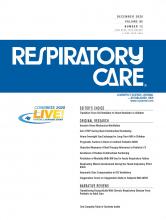Research ArticleSpecial Article
A Flexible Enclosure to Protect Respiratory Therapists During Aerosol-Generating Procedures
Cameron R Smith, Nikolaus Gravenstein, Thomas E LeMaster, Ceri M Borde and Brenda G Fahy
Respiratory Care December 2020, 65 (12) 1923-1932; DOI: https://doi.org/10.4187/respcare.08568
Cameron R Smith
Department of Anesthesiology, University of Florida College of Medicine, Gainesville, Florida.
Nikolaus Gravenstein
Department of Anesthesiology, University of Florida College of Medicine, Gainesville, Florida.
Thomas E LeMaster
Center for Experiential Learning and Simulation, University of Florida College of Medicine, Gainesville, Florida.
Ceri M Borde
Center for Experiential Learning and Simulation, University of Florida College of Medicine, Gainesville, Florida.
Brenda G Fahy
Department of Anesthesiology, University of Florida College of Medicine, Gainesville, Florida.

References
- 1.↵World Health Organization. Coronavirus disease (COVID-19) Weekly Epidemiological Update and Weekly Operational Update. Available at: https://www.who.int/emergencies/diseases/novel-coronavirus-2019/situation-reports. Accessed September 18, 2020.
- 2.↵
- 3.↵
- Li Y,
- Huang X,
- Yu ITS,
- Wong TW,
- Qian H
- 4.
- Lesho E,
- Laguio-Vila M,
- Walsh E
- 5.↵
- Schwartz KL,
- Kim JH,
- Garber G
- 6.↵
- 7.↵
- Ran L,
- Chen X,
- Wang Y,
- Wu W,
- Zhang L,
- Tan X
- 8.↵
- Miller AG,
- Gentile MA,
- Coyle JP
- 9.↵
- Miller AG
- 10.↵
- 11.↵
- Heffernan DS,
- Evans HL,
- Huston JM,
- Claridge JA,
- Blake DP,
- May AK,
- et al
- 12.↵
- Chan-Yeung M
- 13.↵
- 14.↵World Health Organization. Transmission of SARS-CoV-2: implications for infection prevention precautions. Available at: https://www.who.int/news-room/commentaries/detail/transmission-of-sars-cov-2-implications-for-infection-prevention-precautions. Accessed September 18, 2020.
- 15.↵
- Pastorino B,
- Touret F,
- Gilles M,
- de Lamballerie X,
- Charrel RN
- 16.↵
- 17.↵
- Perlis RH
- 18.↵
- 19.↵
- Yang SS,
- Zhang M,
- Chong JJR
- 20.↵
- Leyva Moraga FA,
- Leyva Moraga E,
- Leyva Moraga F,
- Juanz González A,
- Ibarra Celaya JM,
- Ocejo Gallegos JA,
- et al
- 21.↵
- Hill E,
- Crockett C,
- Circh RW,
- Lansville F,
- Stahel PF
- 22.↵
- 23.↵
- Mehta HJ,
- Patterson M,
- Gravenstein N
- 24.↵
- Seger CD,
- Wang L,
- Dong X,
- Tebon P,
- Kwon S,
- Liew EC,
- et al
- 25.↵
- 26.↵UF Health. Procedures for laryngoscopy in a COVID environment. Available at: https://www.youtube.com/watch?v=ZdriBiSOLCg. Accessed September 24, 2020.
- 27.↵
- 28.↵
- 29.↵
- Reason J
- 30.↵
- Maranhao B,
- Scott AW,
- Scott AR,
- Maeng J,
- Song Z,
- Baddigam R,
- et al
- 31.↵
- 32.
- Artenstein AW
- 33.↵World Health Organization. Rational use of personal protective equipment for coronavirus disease (COVID-19) and considerations during severe shortages (Interim guidance). Available at: https://www.who.int/publications/i/item/rational-use-of-personal-protective-equipment-for-coronavirus-disease-(covid-19)-and-considerations-during-severe-shortages. Accessed September 18, 2020.
- 34.↵
- 35.↵
- 36.↵
- 37.↵
- Gore RK,
- Saldana C,
- Wright DW,
- Klein AM
- 38.↵
- Dalli J,
- Khan MF,
- Marsh B,
- Nolan K,
- Cahill RA
- 39.↵
- Simpson JP,
- Wong DN,
- Verco L,
- Carter R,
- Dzidowski M,
- Chan PY
- 40.↵
- 41.↵
- Verbeek JH,
- Rajamaki B,
- Ijaz S,
- Sauni R,
- Toomey E,
- Blackwood B,
- et al
In this issue
Respiratory Care
Vol. 65, Issue 12
1 Dec 2020
A Flexible Enclosure to Protect Respiratory Therapists During Aerosol-Generating Procedures
Cameron R Smith, Nikolaus Gravenstein, Thomas E LeMaster, Ceri M Borde, Brenda G Fahy
Respiratory Care Dec 2020, 65 (12) 1923-1932; DOI: 10.4187/respcare.08568






